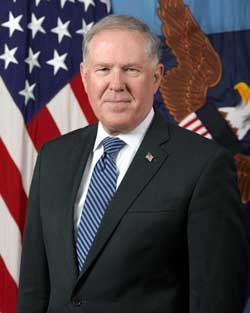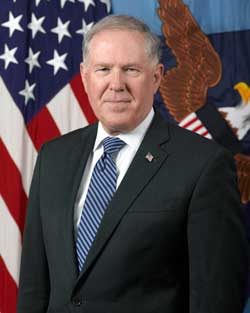
Kendall, Raymond Stress Importance of Space and Space Force’s Success in Separate, High-profile Speeches (Image Credit: SNN)
COLORADO SPRINGS, Co (AFNS) — Secretary of the Air Force Frank Kendall offered unambiguous support Aug. 24 for the still evolving U.S. Space Force, noting the critical role space plays in the nation’s security, the essential functions space enables in everyday life, and why access must be assured as space becomes more congested and contested.
“It is impossible to overstate the importance of space-based systems to national security,” Kendall said during his keynote address at the 36th Space Symposium, an influential, weeklong gathering of military, commercial, and academic space experts from around the world. The speech was Kendall’s first major address since becoming the 26th Secretary of the Air Force on July 28.
“Strategic stability depends on space-based reliable early warning and communications systems,” Kendall said. “… I can assure you that this Administration will continue the work of establishing, equipping, training, and sustaining the newly formed Space Force and of increasing the resiliency of our essential space systems.”
Kendall, a West Point graduate and engineer who has more than 50 years of experience in national defense, spanning time as an Army officer to senior positions in the Pentagon and industry, said the focus on space is crucial to being able to meet emerging challenges from China and Russia. Those challenges, he said, trigger echoes of his experiences during the Cold War.
“I have a visceral understanding, that few in government service today possess, of what it means to have a capable, motivated, and well-resourced strategic competitor,” he said.
Kendall praised Chief of Space Operations, Gen. Jay Raymond for the work he “and others have done to establish the Space Force, but I’m also mindful of the work that still must be done” to address a list of threats that is growing in number and sophistication.
“China has moved aggressively to weaponize space, something that was recognized in the Obama Administration, and that led to a change in the United States’ military strategy several years ago,” he said.
“Both conventional deterrence and conventional operations depend on access to communications, intelligence, and other services provided by space-based systems. As a result, our strategic competitors have pursued and fielded a number of weapons systems in space designed to defeat or destroy America’s space-based military weapons systems and our ability to project power,” he said.
While distinct and different from the Cold War, Kendall said the strategic challenge of today “does involve some of the same features.”
“These include the quest for military advantage through the rapid application of technology to warfare, in innovative operational concepts, and the constant search for exploitable vulnerabilities in each side’s military capabilities,” he said. “I have every hope that there will never be a military conflict, either strategic or conventional, between the United States and our strategic competitors. This is in no one’s interest, but as in the previous Cold War, miscalculation or human error are possible, and a strong deterrent is necessary to reduce the potential for a conflict that no one wants. This is just as true in the space domain as in all others.”
Kendall’s 25-minute address was the second in a pair of featured speeches on Tuesday.
Raymond delivered the first, highlighting the Space Force’s progress and accomplishments since it was formed on Dec. 20, 2019 but, like Kendall later in the day, also pointing out advances from China and other competitors.
“We’ve gone from about 2,100 active satellites on orbit in 2019 to approximately 4,900 today,” Raymond said. “That’s astounding – while we’ve been wearing masks, the number of active satellites has doubled,” he said, referring to disruptions from the coronavirus and the timeframe since the Space Symposium last held an in-person conference.
“Our adversaries have been busy as well. Over the last two years, China and Russia have continued to build an entire spectrum of threats,” he said. That list includes, “reversible jammers” and “ground-based laser systems capable of blinding or damaging satellites.
“China has a satellite with a robotic arm that is on orbit today. This technology could be used in the future to grab other satellites. Both have ground-based missiles capable of destroying our satellites in orbit. They have continued to test those weapons over the last year,” Raymond said.
While emphasizing that “space is hard,” Raymond also highlighted what he said were significant accomplishments that have put the Space Force on a solid foundation and which will propel it forward in a positive way.
“Today, we have a single military service that is empowered with the same authorities as the Army, Navy, Air Force, and Marine Corps, and under the direction of the Department of the Air Force, we have built the Space Force organizations and processes to take advantage of this,” he said.
Raymond also said that the Space Force has established the Space Warfighting Analysis Center to “identify a future force design, underpinned by world-class analysis to balance performance, cost, and resiliency.”
The Space Force has been named as the lead for integrating joint space requirements by the Joint Requirements Oversight Council. “This addresses not only fragmented decision-making, but also lack of integration across the Department of Defense,” Raymond said.
Only two weeks ago, the Space Systems Command stood up to build, test, and acquire space systems and mesh them with other operations and programs across the defense establishment, Raymond said.
And, Raymond said, Space Force is attracting talented personnel.
“In recruiting, we have far more applicants wanting to join the Space Force than we have slots. We can be very selective and are handpicking only the top applicants,” said, adding that 4,000 active duty personnel from the Army, Navy and Marine Corps applied for 650 transfer spots. On the civilian side, he said there 9,100 people applied for 70 headquarter positions.
“People are excited about what we’re building in the Space Force, and they want in,” he said.
Kendall also announced that he is moving aggressively to nominate an Assistant Secretary of the Air Force for Space Acquisition, a position that requires Senate confirmation.
“I am actively looking for candidates, and have a short list of potential nominees for the Secretary of Defense and the President to consider,” he said. “Hopefully there will be an announcement in the not too distant future.”
Both Kendall and Raymond said the focus on space, and its importance to the nation, will not diminish.
Kendall noted the threats as well and said the progression has only accelerated since he and other senior defense officials recognized it when they served in the Obama Administration.
That is why, “Space is very much a part of the ‘one fight’ the Department of the Air Force will focus on,” he said, paraphrasing the “One Team, One Fight” philosophy defining the way Kendall says he – and the Air and Space Forces – will confront challenges.
Kendall suggested he is pleased with the Space Force’s evolution to date, but he said constant assessment and evaluation is necessary.
“I think we have gotten the big parts right, but we should expect to make some changes as we learn from real time execution,” he said.
The reason for that, Kendall said, is clear.
“Success equates to high confidence that the Space Force will make the needed contributions to achieving those missions. Failure is not acceptable.”
News, Department of Defense, DOD, Frank Kendall, Jay Raymond, John Raymond, Space Warfighting Analysis Center, U.S. Air Force, U.S. Space Force, USSFRead MoreParabolic Arc
– Advertisement –









